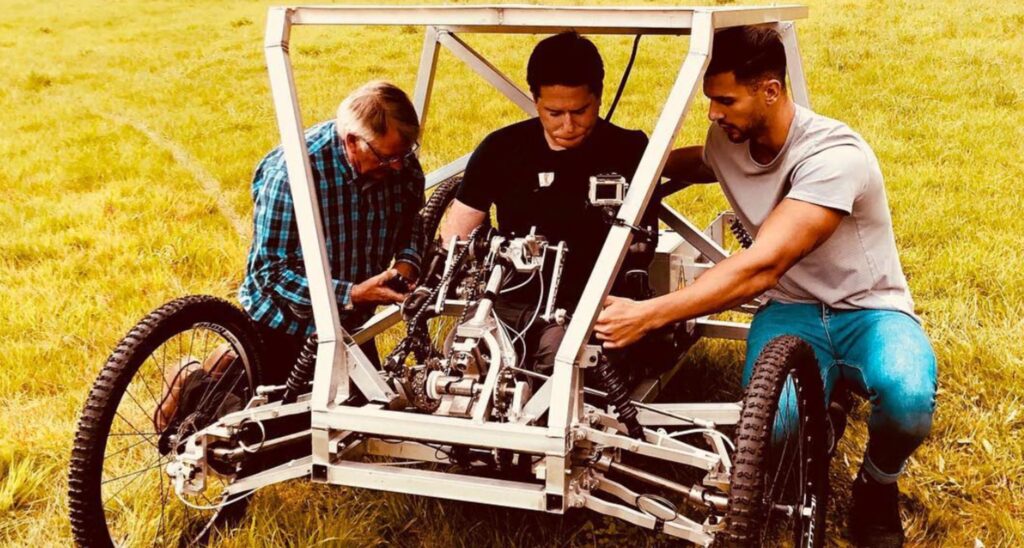The life story of Alex Lewis is like no other. This man refused to give up on his life no matter what it took, and today, he’s thriving with the help of his loving wife Lucy Townsend, and their son.
Alex and Lucy always knew they were meant for each other. When they married and welcomed their son Sam into their life, they felt like the happiest couple on Earth. But then in 2013, around the time Sam turned two, this family’s life took a different turn.

Both Alex and Sam caught the flu, or at least they believed so. However, as the boy got better in a short period of time, Alex wasn’t feeling fine even days after he experienced the flu-like symptoms.
“Because we owned and lived in a pub and came into contact with lots of different people, I assumed it was a seasonal cold and thought it started off as man flu,” Alex told Metro.
Instead of improving, his condition worsened and he became feverish and noticed blood in his urine.
As he could feel something was very wrong, he went to the hospital where doctors told him he contracted a streptococcal infection (type A). Unfortunately, at that point, the infection penetrated deep into the tissue and the organs and caused sepsis. Alex had contracted shock syndrome, septicemia, and necrotizing fascitis – and his body was attacking itself from the inside out.
“I called an ambulance, and within eight minutes, they were there. At the hospital, we went straight into resuscitation, and I was told to say goodbye. His kidneys were shutting down, and they were going to put him on life support,” his wife Lucy told The Guardian.
Doctors’ prognoses were dull. They told the family there was just a three percent chance that Alex would survive as his face and body turned black.
“They were going to turn my life support off, but they wanted to give me one more night to see if I improved, and they wanted to give my family a chance to say goodbye,” Alex told Metro.

“I cannot imagine what Lucy and my mum were going through.
“Having spoken to them since it happened, I think they were more in shock as they couldn’t believe something so incredibly invasive was happening so quickly,” he added.
“I don’t remember being in excruciating pain at this point, but my family remembers seeing me in absolute agony.”
It was determined that a flesh-eating bacteria was poisoning his body so doctors had to amputate his left arm up to the elbow. Sadly, as months passed by, Alex lost all of his limbs, and doctors were also forced to cut parts of his face in order to save his life.
“I can remember seeing my legs in hospital and how they were getting blacker and blacker,” Alex told The Guardian. “The blackness was creeping up towards my waist. I don’t remember seeing my left arm in that condition, but I can remember my legs vividly.”
As Alex lost his lips, plastic surgeon Alexandra Crick took skin from his shoulder in an attempt to fix his mouth.
“It would take me about an hour to eat a sandwich at night, and that was with the help of the nurse,” he told the Daily Mail.
“The last available skin for surgery was on my shoulder,” he explained. “So they replaced the temporary flap with that. All my other skin had to be used for grafts or was scarred.”
“Having my bottom and top lip done at the same time like this was a world first. It’s one piece of skin, and it was like if you imagine placing a bag in your mouth and then sewing around the edges. After the original operation, I had to have them every three or four months.”

Looking at his father, and how different he was, Sam was afraid to approach closer to him, but Lucy found a way to explain to him why his dad looked like that, which wasn’t easy as Sam was just two years old at the time.
After spending months at the hospital Alex could finally go home. The good thing was that doctors managed to save the elbow of his right arm which allowed him to have a prosthetic and be able to use his arm. Eventually, he could speak again as his lip surgery was a huge success.
“That one elbow is his whole independence,” Lucy said.
“I had to relearn everything,” Alex added. “From learning to eat, drink, put my clothes on, to learn to use a prosthesis, and to self propel a manual wheelchair.”
Today, Alex is involved in a number of tech projects which help ease the lives of disabled people. Among the rest, he has tested solar-powered, battery-assisted four-wheeled handles which have been designed by masters students at Southampton University.
Despite his condition, he’s living a quality life and is doing a lot of things, such as kayaking and climbing. In 2019, he climbed one of Africa’s tallest mountains using a specially adapted buggy.
“Since becoming an amputee, I’ve been fortunate enough to try out a number of training methods to keep my fitness up, working with physios and visiting the Help for Heroes training facilities,” he shared with Sports Management.
“I’ve had first-rate guidance, but nothing has been as effective as EMS training, especially in such a short space of time.
“It’s amazing how the machine helps me to engage muscles I haven’t felt since I lost my arms and legs,” he added.
“I feel stronger in training, daily life tasks are easier, and I’ve gained greater confidence that I can take on these challenges.”
His Wild Wheelchairs Project, besides helping improve the lives of disabled people, raises money to finance the construction and operation of a wheelchair manufacturing facility in Ethiopia.
Alex is also a motivational speaker who is happy with his life.
“I’ve lived more of a life in the past four years than I did in the previous 33, and it’s made me realize how much I love Lucy and Sam,” he told Metro.
“There was so much I regretted not doing when I had arms and legs, but I am not letting that happen again. I would not change anything, not in a heartbeat.”
Sam also learned to love his dad for who he is and is proud of him.
We truly admire this brave man’s resilience. His story is proof that no matter the curveballs life throws at us, we should always do our best to end up winners.
Sharon Stone Rocks Bikini at 65, Fans Spot Interesting Detail
Approaching her 67th birthday, Sharon Stone continues to captivate audiences with her timeless allure, as evidenced by a recent striking selfie that has fans buzzing.
The iconic actress, renowned for her roles in ’90s classics like Basic Instinct and Casino, remains a symbol of beauty and grace as she embraces her upcoming milestone birthday.

Reflecting on her groundbreaking performance in Basic Instinct, Stone asserts that the film’s significance extends beyond mere titillation, emphasizing the empowerment it represented for women. Despite being pigeonholed as a sex symbol, she asserts her versatility in a range of roles, from comedic turns to action-packed thrillers.

In her nearly five-decade-long career, the accomplished mother of three continues to stun with her toned physique, unapologetically sharing snapshots that highlight her radiant confidence.
In a daring Instagram post in June 2022, Stone posed by the pool in a green leopard print bikini bottom, exuding self-assurance and embracing her imperfections. Fans flooded the comments section with admiration for her eternal beauty and inspirational demeanor.

But what’s the secret behind Stone’s age-defying allure? According to the actress herself, it’s a combination of mindful living, healthy habits, and regular exercise. From mindful eating to incorporating simple workouts like leg lifts and ThighMaster sessions into her daily routine, Stone prioritizes her well-being with discipline and dedication.

Beyond her commitment to physical health, Stone finds solace in mindfulness practices, drawing from her Tibetan Buddhist beliefs to navigate the complexities of life and aging. Through meditation and self-reflection, she strives to cultivate lasting happiness and fulfillment.

In a recent Instagram post from mid-2023, Stone once again mesmerized fans with her sassy pin-up look, offering a glimpse into her Beverly Hills home. Amidst the chic decor, eagle-eyed viewers spotted a delightful detail stealing the scene: her beloved French Bulldog, Bandit.

As fans marveled at the unexpected cameo, Stone’s Instagram became flooded with comments expressing adoration for her furry companion and delight at the charming snapshot.
In the ever-evolving landscape of Hollywood, Sharon Stone stands as a beacon of grace, resilience, and timeless elegance, captivating audiences with her undeniable talent and unwavering spirit.



Leave a Reply